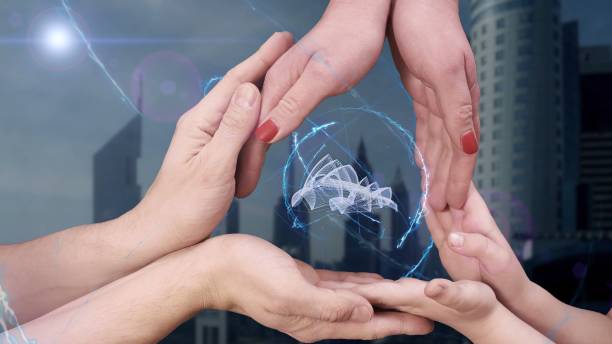Holographic Telepresence: Redefining Virtual Collaboration
The fusion of advanced holographic technology and high-speed telecommunications is ushering in a new era of virtual collaboration. Holographic telepresence, once confined to the realm of science fiction, is rapidly becoming a tangible reality. This groundbreaking technology promises to revolutionize how we communicate, work, and interact across vast distances, offering an unprecedented level of immersion and presence in virtual environments.

Early attempts at holographic communication were limited by technological constraints, resulting in low-resolution images and significant latency. These limitations made practical applications challenging and relegated holographic telepresence to experimental laboratories and tech demos. However, recent advancements in laser technology, spatial light modulators, and real-time rendering have dramatically improved the quality and feasibility of holographic communication.
The Technology Behind Holographic Telepresence
At its core, holographic telepresence combines several cutting-edge technologies to create a lifelike, three-dimensional representation of a remote participant. High-resolution cameras capture the subject from multiple angles, while depth sensors map the spatial information. This data is then processed in real-time and transmitted over high-bandwidth networks to the receiving end.
The receiving system uses advanced projectors or specialized displays to recreate the three-dimensional image. Some systems employ rotating screens or volumetric displays to achieve a true 360-degree holographic effect. Others use transparent screens or augmented reality headsets to overlay the holographic image onto the real environment, creating a mixed reality experience.
Crucial to the success of holographic telepresence is the network infrastructure that supports it. Ultra-low latency connections are essential to maintain the illusion of real-time interaction. As such, the rollout of advanced networking technologies is closely tied to the development and adoption of holographic communication systems.
Applications and Impact
The potential applications of holographic telepresence span various industries and use cases. In the corporate world, it offers a more engaging alternative to traditional video conferencing, allowing for more natural and nuanced communication in virtual meetings. Executives can appear as holograms at multiple locations simultaneously, reducing travel time and costs while maintaining a strong personal presence.
In healthcare, holographic telepresence enables remote consultations and surgical assistance with unprecedented clarity and depth perception. Specialists can virtually “stand beside” local doctors, providing guidance and expertise in real-time, potentially revolutionizing telemedicine and medical education.
The entertainment industry is also poised for transformation. Live performances can be beamed to multiple venues simultaneously, allowing artists to reach global audiences without the need for extensive touring. Museums and educational institutions can use holographic technology to bring historical figures to life or showcase rare artifacts in stunning detail.
Challenges and Limitations
Despite its promise, holographic telepresence faces several challenges. The high bandwidth requirements for transmitting holographic data in real-time pose a significant hurdle, particularly in areas with limited network infrastructure. Additionally, the cost of specialized holographic display systems remains prohibitively high for widespread consumer adoption.
There are also technical challenges related to image quality, color reproduction, and viewing angles. Creating convincing holographic images that maintain their integrity from multiple viewpoints is a complex task that requires further refinement.
Privacy and security concerns also loom large, as holographic telepresence systems capture and transmit highly detailed personal data. Ensuring the protection of this information from interception or unauthorized use is crucial for the technology’s acceptance and widespread adoption.
The Future of Holographic Communication
As technology continues to advance, we can expect significant improvements in the quality and accessibility of holographic telepresence systems. Research into new display technologies, such as photonic crystals and metamaterials, may lead to more compact and affordable holographic devices.
The integration of artificial intelligence could further enhance holographic experiences. AI-powered systems could potentially generate realistic holographic avatars based on minimal input data, or even create synthetic environments for holographic interactions.
The convergence of holographic telepresence with other emerging technologies, such as haptic feedback systems and brain-computer interfaces, could lead to even more immersive and multisensory remote communication experiences.
As we move towards a more interconnected world, holographic telepresence stands at the forefront of communication technology, promising to bridge physical distances and create new paradigms for human interaction. While challenges remain, the potential of this technology to transform how we work, learn, and connect with one another is undeniable. The coming years will likely see rapid advancements in this field, bringing us closer to a future where holographic communication is as commonplace as video calls are today.





